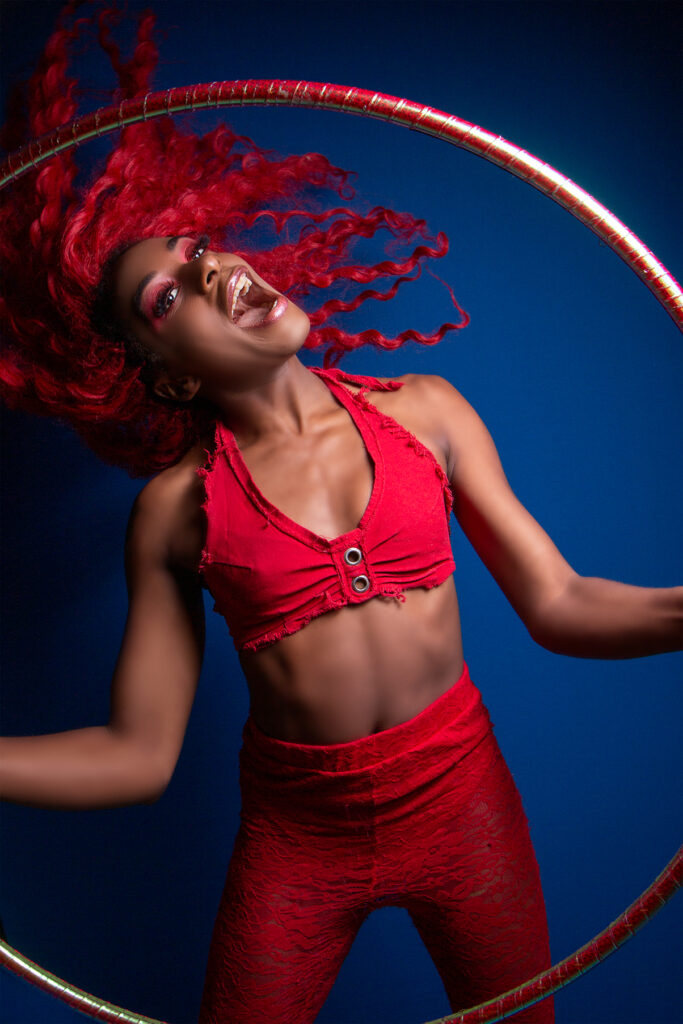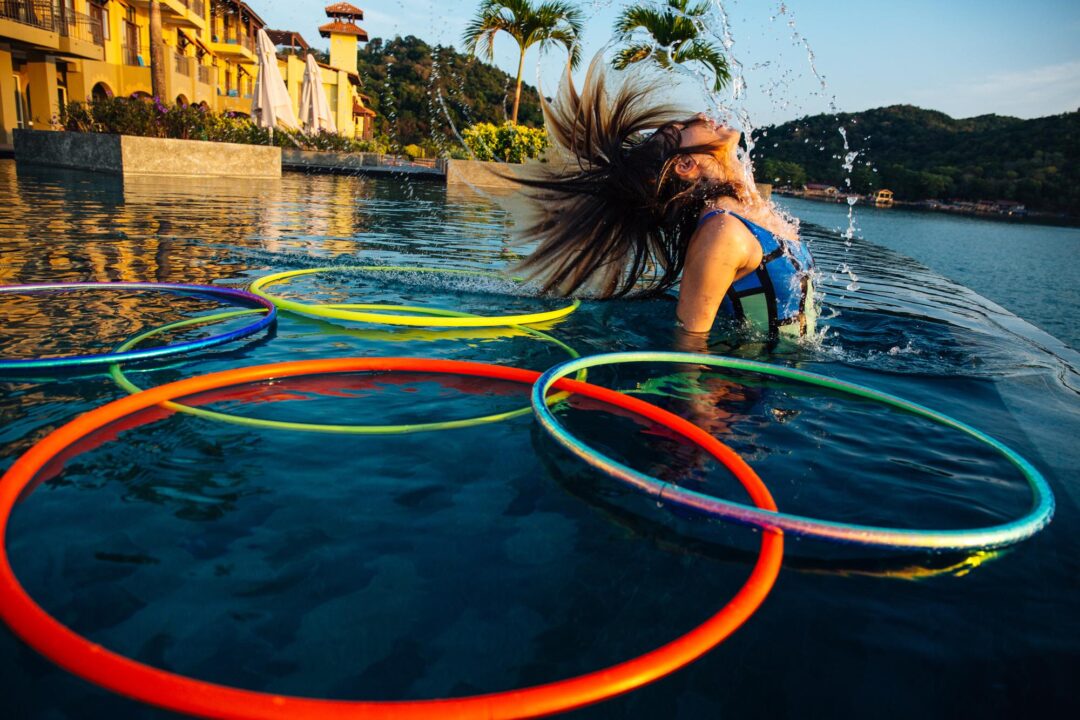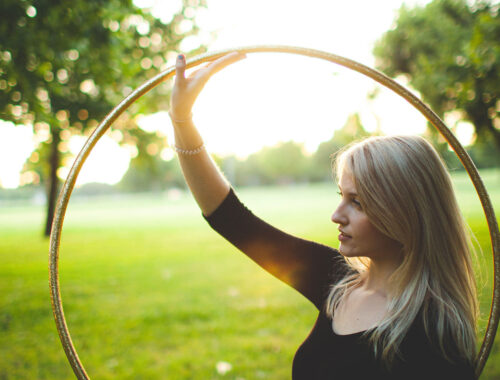Welcome Hoopers!
Whether you’re new to hooping and aren’t sure where to start, or are looking to refresh your practice, look no further!
Think back to your happiest memory; where time felt like it was stopped, when your senses were in-tune, and you were completely present. This euphoric state of mind can be achieved through movement, exercise, and creative expression is commonly known as the “flow state”, “movement meditation”, or compared to “runner’s high”. Now, imagine an activity that could transport you to that blissful, peaceful place?
Hula hooping, or hoop dance, is a playful, aerobic exercise, and is fabulously effective in helping reach fitness goals. Hooping also increases energy levels, confidence, dexterity and coordination, mental clarity, as well as providing a sense of achievement. With mental-health issues, stress, anxiety, and depression at an all time high, people are exploring creative ways to emote, express, release, and play. Some are learning a new sport, or a new style of fitness, while some are exploring their favorite childhood toys and pastimes.
If you’re brand new to hooping, internet searches can be confusing and overwhelming. Here at Hoopologie, we’ve created a Beginner Hooper Guide starting with the basics including; beginner hoop recommendations, differences in tubing, grip (tape, sanding, wax), posture, tips for success, and more.
Lets get started!
What size hoop is best for me?
Hoopologie’s standard Beginner Hoop recommendation is a 40″ diameter hoop or larger, made with a minimum of 3/4″ diameter tubing, but preferably, 7/8″ diameter tubing. Many hoopers’ first hoops are heavy, weighted fitness hoops from their local department stores or internet searches and are often 2lbs or heavier. Our heaviest fitness hoops are 1.2 – 1.5lbs, making a mid-weight hoop that is suitable for hoopers developing their muscle memory, while light enough to not leave bruising and soreness.
What different kinds of tubing are available and which one should I choose?
Polypropylene (Polypro): Polypro tubing is the most widely available and popular type of tubing on the market today. Polypro is a light, bouncy, and responsive tubing that is loved by hoopers of all experience levels. While quite durable, polypro has its weaknesses. It can be fragile in extremely cold climates, suseptable to warping and misshaping in extreme heat, and can crack under pressure.
High Density Polyethylene (HDPE): HDPE is a fan favorite amongst hoop makers and hoopers alike. HDPE is a light, durable tubing, with a firmness unlike polypro, yet responsive and quick moving. Hoop-smiths everywhere love HDPE tubing for its forgiving attributes, ability to retain its shape, and ease to cut and manipulate.
Polyethylene (PE): PE tubing identical to the black irrigation tubing found at many hardware stores, only Hoopologie made it custom in white. This tubing is a medium weight ideal for beginner – intermediate hoops.
Stardust (Polypropylene): Stardust tubing is a proprietary blend, custom designed by and made for Hoopologie. This stunning, glittery tubing is a show-stopper, especially in the bright sunshine! Stardust tubing is specially made to be more bouncy, more responsive, and more grippy. These attributes can have side effects that can affect this tubing – it is more delicate in colder temperatures and can crack with impacts on hard surfaces. *Stardust tubing is not recommended for newer hoopers or children*
What kinds of grip options are out there and which one should I choose?
While few things feel as nice as a fresh hula hoop with no scuffs, scratches, or markings, a perfectly smooth hula hoop can be increasingly challenging to maintain a level and consistent spin. There are many grip options out there, here are the most common:
Sanding: Sanding is the most budget friendly grip option and allows each individual hooper to choose their intensity of grip.
TIP: Gently rub a piece of fresh sandpaper around the inner rim of your hoop 1-2x or until desired result is achieved.
Wax: Hoop wax is often made with a bees-wax base and is applied in a similar way as sanding. Hoop wax is made in-house and can be purchased as an addition to your hoop.
TIP: Hoop wax is not recommended for taped hoops
Tapes (gaffer, electrical, low-profile, and 3m): Many beginner hoops made today are crafted with grip tape.
Electrical tape has a smooth, yet grippy texture and is quite durable.
Gaffer tape comes in many colors and widths, making it a great addition to both bare and taped hoops, however, gaffer tape’s adhesive may weaken if exposed to too much moisture.
Low-profile grip tape is a durable, thin, and grippy tape, perfect for bare polypro and HDPE hoops. *Not recommended for taped hoops*
3m is a soft, textured surface at 33 mils (0.8 mm) thick that is durable and abrasion resistant. 3M tape adds amazing grip and cushioning to all kinds of hoops.

Travel Hoops vs Sectionals vs Collapsible
Love taking your hoop every where with you? Many hoops are fastened closed with tape, a connecting joint, or some combination of the two, making it challenging carry your hoop with you. Over the last few years, hoops have begun to be made with a push-button connection.
The Collapsible hoop allows the hooper to disconnect the hoop at its joint and coil it down to attach to a bag, etc.
Sectional and travel hoops are gaining more and more popularity, allowing hoopers to take their hoops any and every where with them – the Hoopnotica Travel Hoop is perfect for beginners and experienced hoopers alike; made with 1″ diameter tubing, push-button connectors, spiraled with beautiful mirror tape and gaffer (grip) tape, a travel strap and can be connected with 6 segments to create a 42″ diameter hoop, and 5 segments to create a 37″ diameter hoop.
Posture, Stretching, and Breathing exercises.

Hoop dance helps hoopers of all body types increase mind/body connection, coordination, stamina, energy levels, and mental clarity. When you first begin hooping, you may feel muscle activation of muscles you didn’t know existed! You may experience some mild soreness when you first begin hooping, though there are a few postural adjustments you can make to extend your practice times and feel more receptive to new muscle memory connections.
Before hooping: Hydrate, especially if you’re living and hooping in hot or very dry climates, or dancing in the direct sun.
Stretch: With your hoop; lift your hoop over head and do a few, slow, mindful stretches to each side. Forward fold while holding your hoop in front of you, soften your knees and hinge from your hips rather than rounding over your low back. Quad stretch – hold your hoop in front of your body, step one foot the hoop, hook your hoop on your back-leg ankle and gently lift your leg in the air until you feel a stretch in your quad. Repeat on each side. Open your shoulders *hoop optional* – windmill one arm at a time in a forward circular motion for 30 seconds, reverse the rotation of your hand and repeat on each side, in each direction for 30 seconds.
Posture: Keep your knees and elbows soft – don’t lock your joints out. Relax your shoulders down your back, lift your sternum, rest your facial muscles, and find a comfortable and sturdy stance. Intentional breath can immensely help your practice, focus, energy levels, and mood – so don’t forget to take steady and calm breaths and allow your body to move through your flow.
Tricks and Tutorials
Hoopologie’s Ambassadors
Eshna Kutty – @eshnakutty
Nicole Goss – @blackgurlhoopin
Mykah Smith – @bahamahoopyogi
Morgan Jenkins @missmojangles
Amanda Brewer – @misshoopdido
Lee Jeffries – @photographlee
Jocelyn Gordon – @hoopyogini_worldwide
Michele Clark – @michelefrancisclark
Symoné – @symoneforever
Shani Blueford – @shani_anne_marvelous
Chloe Somers Wall – @thechloesomers
Emma Kenna – @hoopingmad
Sanda Safire – @safirehoopdance
Mike Hayataka – @thathoopguy
Ali Padiak – @alihoopmama
Marianna De Sanctis – @mariannadesanctis
Twisted Orbit – Bags & Valentina – @twistedorbit
Gail O’ Brien – @gailobrienhoop
Lisa Looping – @lisalooping
Lisa Lotti – @lisa_lotti
Trixie Turvey – @trixieturvy
Ninja Hoops – Zach & Marria – @ninjahoops
Kenya Fluroscente – @kenyaflowrescente
Kate Ryan – @kateryancircus
Hillia Hula – @hillia_hula
Jenny Tufts – Circle Cirque – @circlecirque
Sky Flow Artist – @skyflowartist
Ben Cirka – @bencirka
Anna Fisher – @annafisher_
Top Recommended Instructors
Deanne Love – @deannelovexo
MadAboutHoops – children’s classes/summer camps – Madison McBurney and Amy Neel – @madabouthoops.

Hoopmakers University
A comprehensive guide for hoopsmiths and hoopers – answering all of your questions from deciphering sizing of tubing, tubing types, how to create the perfect connection, the tools you’ll need to create a hoop, and beyond!!


